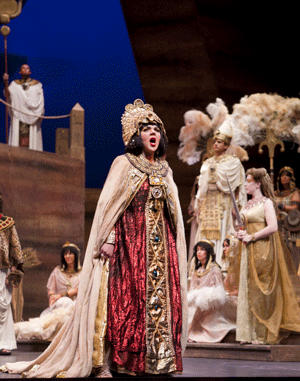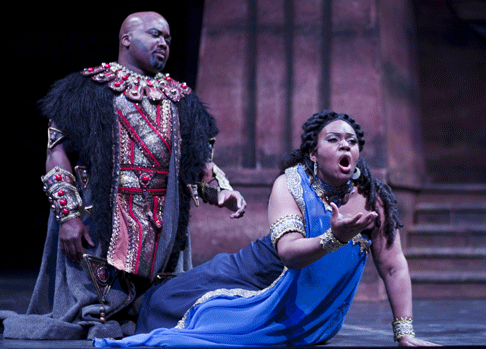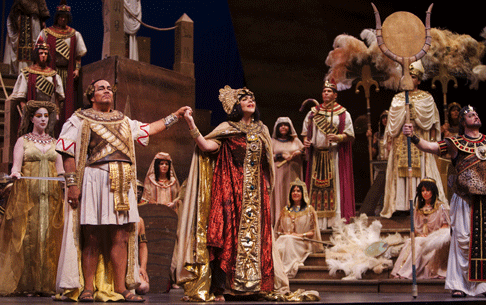They symbolize the buoyant optimism that surrounds this rising company after several years under General Director Scott Altman. Budgets are in the black and artistic quality is rising. Aida is an ambitious work for any company, and Arizona Opera delivered a strong performance on the first of five sold-out nights in Phoenix and Tucson.
 Daveda Karanas as Amneris
Daveda Karanas as Amneris
In an era where opera companies must watch the bottom line, conveying the grandeur of this spectacular work poses a unique challenge. Arizona borrowed a set from New Orleans Opera by Canadian designer Philip Silver, which provided two-dimensional, minimalist faux-massive painted drops, accessorized with exotic statues. The latter were sometimes in Egyptian style, with impressive results in the Nile scene, and sometimes just generically ancient. Nashville Opera Director John Hoomes directed in a traditional but effective manner. The Triumphal Scene parade inevitably seemed a bit thin, but the audience was distracted by live animals—two dogs and the return of one of the camels. To its credit, the set design pushed the action to the front of the stage, boosting the vocal acoustics in Phoenix’s large multi-purpose hall.
 Kevin Short as Amonasro and Lisa Daltirus as Aida
Kevin Short as Amonasro and Lisa Daltirus as Aida
Aida was cast with a strong and well-matched set of regional-level American singers. To the title role soprano Lisa Daltirus brings a silvery tone, gossamer high notes, and intelligent phrasing. She used these qualities to make a memorable success of moments many sopranos fear, such as the infamous dolce high C in “O patria mia.” Yet the role of Aida demands not only this, but powerful low notes and passionate utterances that cut through heavy orchestration, which Datirus rarely delivers. While her characterization had integrity and pathos, at times she seemed to be tip-toeing through it.
Chicago-based Tenor Arnold Rawls is similarly more comfortable at the top than the bottom of the range required for RadamËs. His lack of a fine-spun piano and unvarying color undermined quietly transcendent moments, as in most of the final scene; but elsewhere Rawls made satisfying use of vocal warmth, stentorian high notes, and fine phrasing. “Celeste Aida,” for example, was phrased impressively on one breath into the second verse, and—after some savvy preparation—ended on an impressively long and ringing b-flat.
 Rebecca Sjowall as High Priestess, Arnold Rawls as Radames, Daveda Karanas as Amneris and Peter Volpe as Ramphis
Rebecca Sjowall as High Priestess, Arnold Rawls as Radames, Daveda Karanas as Amneris and Peter Volpe as Ramphis
As Amneris, Greek-American mezzo Daveda Karanas, a graduate of cross-town Arizona State University, possesses a tightly focused, slightly steely voice that easily penetrated the orchestra—rather in the mold of Fiorenza Cossotto. Her interpretation is that of a mature artist, and she is a compelling actress. The voice lacks—perhaps as of yet—quite all the warmth, color and amplitude that the greatest exponents of this role possess, but her traversal of this role in a smaller theater—she is slated to sing the role at Glimmerglass Opera this summer—would be worth traveling to hear.
Altman favors even casts with strong voices in smaller roles, particularly lower male parts. Amonasro does not require great subtlety, and Kevin Short, an American baritone based in Europe, did not provide it—but he was commanding when it mattered. The veteran Ramfis, Peter Volpe, displayed a voice of impressive weight and color. In an era of soggy Verdi conducting, Steven White proved refreshingly willing to push the tempo along, achieved some lovely transitions and orchestral balances, and kept the forces together in the face of a few opening night mishaps.
Andrew Moravcsik
image=http://www.operatoday.com/OptGF3X9406.gif
image_description=Arnold Rawls as Radames [Photo by Tim Fuller / Arizona Opera]
product=yes
product_title=Giuseppe Verdi: Aida
product_by=Click here for cast and production information.
product_id=Above: Arnold Rawls as Radames
Photos by Tim Fuller / Arizona Opera